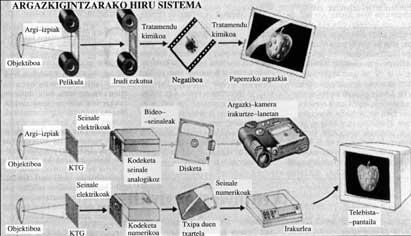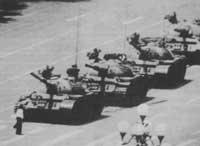Photos on computer screen
1993/03/01 Otaolaurretxi, Jon Iturria: Elhuyar aldizkaria
Cameras using a digital or numerical system have extraordinary advantages over conventional cameras. Because they do not take the photo in the movie, but on a floppy disk, and then the image can be seen on the computer screen. With the image on the screen you can touch, sort, stand, etc. before saving it to disk, hard drive or CD (compact disk). Using the modem and telephone line you can send the image anywhere in the world.
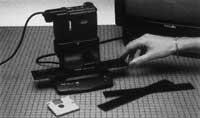
In recent times cameras with diskette (and not film) as photographic support are entering the market with force. Electronic cameras can be analog or numeric (digital) depending on the type, but in any case you can see clearly the problems that usually occur to project the slides (you need a dark room, find a suitable distance between projectors and screens, do not put the photos upside down, etc.) that will end shortly.
As we all know, in homes there are already many TV monitors that are video consoles and that is functioning as a cinema screen, but from now on there are not only films, but also own photos (family, holiday, etc.) you can see them. In addition, associated with the computer, professionals will be able to classify their files, place captions, “touch” the images or send them by phone anywhere. During the Gulf War, Japanese and American journalists tested this system.
Analog cameras
The year 1992 that we have just crossed has been that of numerical photography. Analogue electronic photography was already known. In these cameras the image is recorded as a continuous analog signal (as in the video band), but in the so-called digital or numeric cameras the image becomes a set of computer data (they are the data obtained by the combination of one and zero), each data corresponds to a pixel of the image (it is the abbreviation of the terms picture ³) or a quadruple. In all of these cameras, the conventional emulsion film is replaced by a CCD base support ( Charge Coupled Device) that converts light into electrical signal via photosensitive cells.
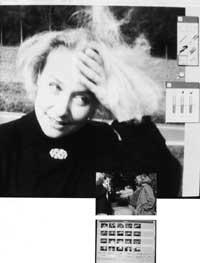
Canon has been offering its Ion system for two years. It is a magnetic device called Still Video Camera and about 120,000 pts. Valid. In a small 2 inch (about 5 cm) diameter floppy you can record 50 color images. The image is taken on the floppy disk at 235,000 pixels (786x300), but as in the music booths you can delete it whenever you want, to give way to another.
To view the images simply connect the camera to TV such as the magnetoscopes or trucks directly to the Y/C input. They can be passed through the screen through a remote control that is supplied with the device, after making the sum of photos. These images can be collected in video and passed as a slideshow, music, word, etc. attached.
And to the “old” photos we have already made, what do we do? No need to worry. The negative slides or photos we already have can be portrayed with the Ion camera and passed to the floppy 30,000 ptas. with an environmental value conditioner. In this way, the professional photographer can classify his photographs by themes, by years or as he wishes and then watch them quickly on television without using originals whenever he wishes.
Other houses have also launched new analog cameras. Nikon has for sale the model QV-1000 C, Sony is named ProMavica, in addition to some models of Olympus and others of Minolta. Although currently only sold in Japan and the United States, the ProMavica camera is reflex type and accepts all the objectives of Canon, Nikon and Sony. For the red, green and blue signal (for each of them) it has a triple CCD system that allows to obtain an image of 380.000 pixels.
Fully digital camera
Also included are cameras that capture the image digitally: For example, the DCS (Digital Camera System) of Logitech or Photoman or Kodaks. When connecting directly to the computer, images can be treated immediately. The Photoman camera is small and 140,000 pcs. Environmental value. It is very light and the focal length is fixed (equivalent to 55 mm in classic cameras), with a definition of 106.000 (376x282) pixels that can take 32 images to whiten.
Images are stored on a camera chip (RAM) and can be connected at any time to the office or home microcomputer, for example to a PC or compatible. Images look like this on the computer screen. In addition, the Fototouch program allows to treat images in 256 shades of gray. Once the image is saved, it can be used in everything: for electronic editing, to complete the file, to send it by modem to anywhere, etc. Since the image occupies approximately 100 kilobytes, 14 images can be inserted into a normal 1.4 MB floppy disk.
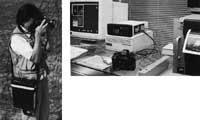
The Kodak DCS model is much more advanced. It is based on Nikon's F3 reflexa (so you can use its full range of optics) but the film is replaced by a 1.280x1.024 pixel CCD stand. Bleaching figures and coloured DC3 stand are taken on the DM3 stand. They have a definition of 1.3 million pixels and can be said to be equivalent to the quality achieved on HD television. CCD sensitivity resembles silver emulsion ISO 200-400 sensitivity films in color figures and 400-800 isos in bleaching. This camera also has motor and is able to take 2.5 images per second. Having a memory of 8 MB (expandable up to 32 MB), you can hit a set of six figures (or 24). These captured images are emptied into a digital memory called DSU (Digital Storage Unit).
The memory weighs six kilos and the photographer hangs in a box. It has a capacity of 200 MB and can include 156 photos (6 rolls of 36 photos), but if the images are compressed up to 600 photos can be included in the memory. The aforementioned DSU memory is powered by a 12 V battery and in addition to the control keyboard has a small screen of 10 cm to be able to immediately view and control the recorded photos. Unlike the cameras of Ion and Logitech of Canon, Photoman, with the DCS of Kodaken, the photographer has full autonomy, since he can control his work at any time, regardless of where he is.
DCS images can be passed to the Macintosh computer (model II or SE/30 for example) or to the PC via the SCSI door. In addition, the DCS camera (and also Photom) can be connected to the laptop. The Kodak DCS camera, however, costs between three and four million pesetas and is currently only available to professionals. The Kodak XL-7700 printer can be used to print the images afterwards.
Fully digital cameras, such as DCS or Photoman, can be connected directly to the computer, but Sony's Can Ion or ProMavica analog cameras have to convert the analog signal into digital. For this it is necessary to have a graphics card on the microcomputer. Therefore, Canon offers a digitization card (768x576 pixels) for PC installation along with the Ion RC-260 camera at about 300,000 pesetas and the program you need. These images can then be extracted on the laser printer, such as the Can CLC-500 model.
It is clear, therefore, that “chemical” photography was born about 150 years ago. In the 20th century the system will be historical and totally obsolete.

Gai honi buruzko eduki gehiago
Elhuyarrek garatutako teknologia



